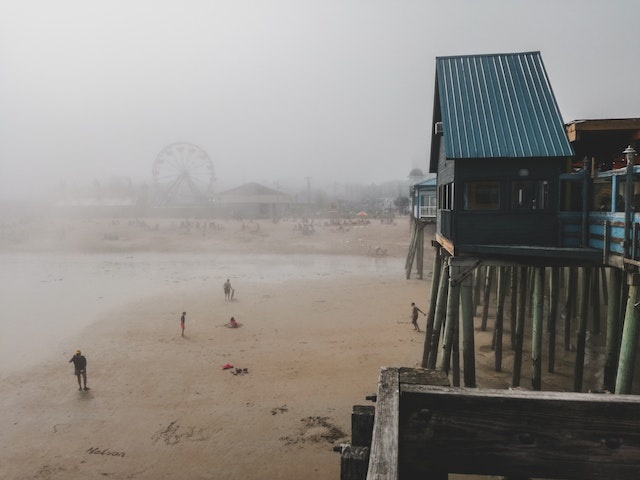Hurricanes are powerful storms that bring life-threatening hazards to people living in both coastal and inland communities. Though you may first think of wind when envisioning a hurricane, water hazards are historically the deadliest. However, in actuality there are three major hazards of hurricanes — storm surge, heavy rainfall, and intense winds. The National Oceanic and Atmospheric Administration (NOAA) and I will give you actions you can take before, during, and after tropical weather to protect your life and property.
Storm surge occurs when wind from a storm drives water onshore, causing an unusual and rapid rise in water level. Larger, stronger storms typically produce the greatest storm surge flooding. You may notice weather experts focus on the high tides during a hurricane, that’s because storm surge occurring during high tides cause the worst damage forcing up to 20 feet of water onshore during the height of a storm.
Heavy rainfall is a hallmark of a hurricane. Rainfall can be measured in feet during the worst storm. The weather service and other experts remind us to never try to traverse floodwaters or compromised bridges. We should always remember the mantra “Turn Around Don’t Drown.” Flooding downstream leads to many deaths following a hurricane.
Fierce winds contribute to the deadly aspects of hurricanes. Categories of hurricanes are solely based on wind speeds. For example, a Category 5 storm has the highest wind speed which exceeds 157 miles per hour. Hurricane Andrew, which slammed Miami in 1992 had a recorded wind gust of 164 miles per hour. Catastrophic damage occurs during the strongest of storms; it is common that cars are lifted in the air, houses are flattened and entire swaths of land lay barren.
Preparing for a hurricane
In order to be prepared for storm season there are a few commonsense steps that you can take. These steps can protect you and your family as well as your organization and employees. Take time now to be prepared and know your risk.
- Risk Analysis – Determine the risks to you, your family and business. Find out if you are in an evacuation zone and determine if storm surge is a risk.
- Create an Evacuation Plan – Understand your evacuation routes and determine how you will go if there is an active evacuation order. Think about multiple routes to safety in case your primary route is not available. Many people evacuated New Orleans during Hurricane Katrina by driving west on Interstate 10 however you do not need to travel hundreds of miles to safety. Regardless of your route make sure that your destination provides protection from hurricane hazards.
- Assemble a “bug out kit” – Have at lease three days of supplies on hand and be prepared to be on your own. Emergency responders and municipalities will be busy with restoration and recovery operations. You will need to be self sufficient for a period of time. Have on hand fresh water, non-perishable foods, seven days of medicines and pet supplies. If you are staying in place fill your bathtub with water so that you can use that water to flush the toilet if water service is cut off. Ensure that you keep cash on hand as many point of service devices will be with out power. Solar powered USB chargers may be worth purchasing in order to be able to communicate.
- Insurance – Check with your insurance provider or broker to determine limits of coverage before hurricane season. There is usually a waiting period before a policy goes into effect. For those that live or operate businesses on the coast check with the National Flood Insurance Program.
- Fortify your home or business – Make your property more resilient by purchasing plywood or aluminum panels to board up windows and doors. Secure loose outdoor items and furniture. Remove files from bottom drawers in flood prone areas of your business and have tarps on hand to cover important equipment and supplies.
- Be neighborly – Look in on your neighbors, especially the elderly before, during and after the storm.
- Do not forget the pets – Make sure that you have a plan to protect your pets. One of the lessons learned from Hurricane Katrina was that there was inadequate planning for pets which left many of them on their own.
- Formalize your plan – Make sure that you record your plan. A homeowner can simply write their plan on paper or in Word. A business should have a formalized Hurricane Preparedness Plan written in a SaaS business continuity management software which incorporates all elements, including personnel, tasks, resources and recovery times. Share your plan with family members and if a business with your employees and all important stakeholders.
During a hurricane
Typically, we will have a three-to-five-day window once a threat is recognized. During this time, pay attention to the track of the storm and projections from the experts. Remember that the cone of uncertainty is an estimation of the center of the storm’s track and that the storm can follow any route within that cone. Follow evacuation orders if they are issued and be ready to go if your area has not been ordered to go.
- Be prepared to shelter in an interior portion of your home. Get as far away as you can from windows and doors. Remember that winds can exceed 100 miles per hour making any object a lethal one.
- Resist the temptation to go outside during the “eye of the storm.” This quiet period of the storm that the eye passes, and it can end very suddenly.
- Stay out of flooded areas and remember that just six inches of water can knock an adult off of their feet. Flood waters also contain contaminates and carry disease.
After a hurricane
Once a hurricane passes does not mean that you are out of the woods. There will be significant work to do.
- Overexertion is a concern. Many people will want to get out and start to recover immediately. Remember to hydrate, take breaks and know your limits.
- Know how to safely operate your generator. Think safety as you run your generator. Never run one inside your house as you can suffer carbon monoxide poisoning. Make sure that you have a transfer switch that separates your generator power from the main pane. You never want to energize the power lines to your house. This represents a fatal hazard for the line workers trying to restore power.
- Power tools can lead to injuries. Seek assistance if you are unfamiliar with your power tools. Chain saws and other cleanup tools can lead to injury.
- As you start to reemerge remember to keep road flooding risks in mind and do not drive across flooded roads.
Hurricanes are extremely strong storms that wreak havoc on both business and the community. Having a plan in place ensures that your business or family are ready to weather the storm. We should be prepared, use common sense and care for our families, coworkers and neighbors.
Sources
Hurricane safety, explained | National Oceanic and Atmospheric Administration (noaa.gov)


